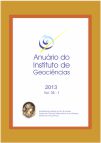Les Basaltes de l'Atlas de Béni-Mellal (Haut Atlas Central, Maroc): un Volcanisme Transitionnel Intraplaque Associé aux Stades de L'évolution Géodynamique du Domaine Atlasique
DOI:
https://doi.org/10.11137/2013_2_70_85Resumo
The basaltic rocks emitted at the synclinal basins of the Atlas of Béni-Mellal, show entablatures shapes constituted by interbedded lava flow successions with red silted-sandstone layers (Red Beds). In the synclinal basins of the area, basaltic lavas form two volcanic sequences B1 and B2 which correspond to distinct volcanic events. Pyroclastic deposits are rare. Basaltic outcrops show no pillow lavas. The lava flows were emplaced while the sediments were still soft and unconsolidated. The original flows fissure bet up to the open air, or under very shallow water. Ages of basaltic flows grouped around two distinct values t hat correspond to the Middle Jurassic (B1 basalts) and to the last of the Lower Cretaceous (B2 basalts). Basaltic rocks consist of olivine basalt. Textures are variable and dependent of the type of structure. Lavas flows typically show porphyritic texture at the bottom of entablatures, fluidal structure in its inner parts and vesicules at its upper zone. Clinopyroxene compositions range from augite in B1 to diopside in B2 basaltic horizons. Whole rock compositions mark the transitional character of these volcanic rocks. Normative composition show low nepheline contents (≤ 5%). LREE/HREE ratios are low and clearly less enriched than those obtained for alkaline magmatic series. Spidergram spectra are similar to those of Oceanic Island basalts (OIB). The relative geochemical dissimilitude reported at the both basaltic sequences B1 and B2, indicate, eventually, the changing of the magmatic regime, which becomes from tholeiitic to purely alkaline in Cenozoic, in relation to the geodynamic evolution of atlasic domain. This geodynamic and geochemical evolution is ruled by two major events: the opening of the Central Atlantic and the Mediterranean convergence.Downloads
Publicado
2013-01-01
Edição
Seção
não definida
Licença
Os artigos publicados nesta revista se encontram sob a llicença Creative Commons — Atribuição 4.0 Internacional — CC BY 4.0, que permite o uso, distribuição e reprodução em qualquer meio, contanto que o trabalho original seja devidamente citado.
















 Exceto onde indicado de outra forma, o conteúdo deste site é licenciado sob uma licença
Exceto onde indicado de outra forma, o conteúdo deste site é licenciado sob uma licença 